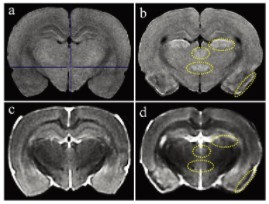Magnetic resonance imaging (МРТ) in small animals is a powerful non-invasive tool that can be used to detect a wide variety of lesions.
A novel compact high-performance small animal MRI platform takes a novel magnet design and application-based approach to reduce the cost and complexity of conventional systems. Система мобильна, самозащищена и может быть размещена в большинстве исследовательских учреждений.. Не требуется хладагент или электроснабжение.. Преимущество этой новой системы перед обычными системами МРТ заключается в том, что она может легко обеспечить четкие цифровые 3D-морфологические изображения всего органа-мишени..
В анализе МРТ мелких животных, Время релаксации спин-латши (Т1) и время релаксации спин (Т2) Значения часто встречаются, нормальные закономерности которых варьируются в зависимости от органа, салфетка, и жидкость. Когда травма головного мозга была вызвана у крыс, Сигналы T1 и T2 были соответственно изменены из -за изменений ткани; Эти изменения изображения T1 и T2 позволили нам обнаружить индуцированную травму головного мозга.
Пилокарпин, мускариновый холинергический агонист, широко распространенный препарат для индукции эпилепсии и морфологического повреждения нейронов в мозге крысы. В этой модели травмы нейронов, Четкая гистологическая травма головного мозга может наблюдаться во многих частях мозга, такие как пирориформная кора, боковое дорсальное ядро таламуса, Гиппокамп, и субстанция nigra.
Фигура 1 показывает взвешенные изображения МРТ T1 и T2. По сравнению с контролями, Животные, обработанные пилокарпином, показали высокий сигнал T1 в пироформной коре, боковое таламическое ядро, ретроспециплярный ядро таламуса, и заднее ядро гипоталамуса мозга (Рисунок 1a и b). В T2-взвешенных изображениях животных, обработанных пилокарпином, по сравнению с контролями, Низкий сигнал T2 наблюдался в пироформной коре, соответствует областям высокого сигнала T1 (Рисунок 1C и D). Интенсивности сигналов T2 другого 3 Области высокого сигнала T1 были сопоставимы с областями в контрольной группе (умеренная интенсивность) (Рисунки 1C и D).
Applicability of an easy-to-use compact small animal magnetic resonance imaging system in the clinical toxicology-pathological examination of pilocarpine-induced rat brain injury. Высокие сигналы T1 и Low T2 показали заметное гистопатологическое повреждение нейронов, Хотя гистопатологическое исследование было более чувствительным.
 заплесневелый
заплесневелый
